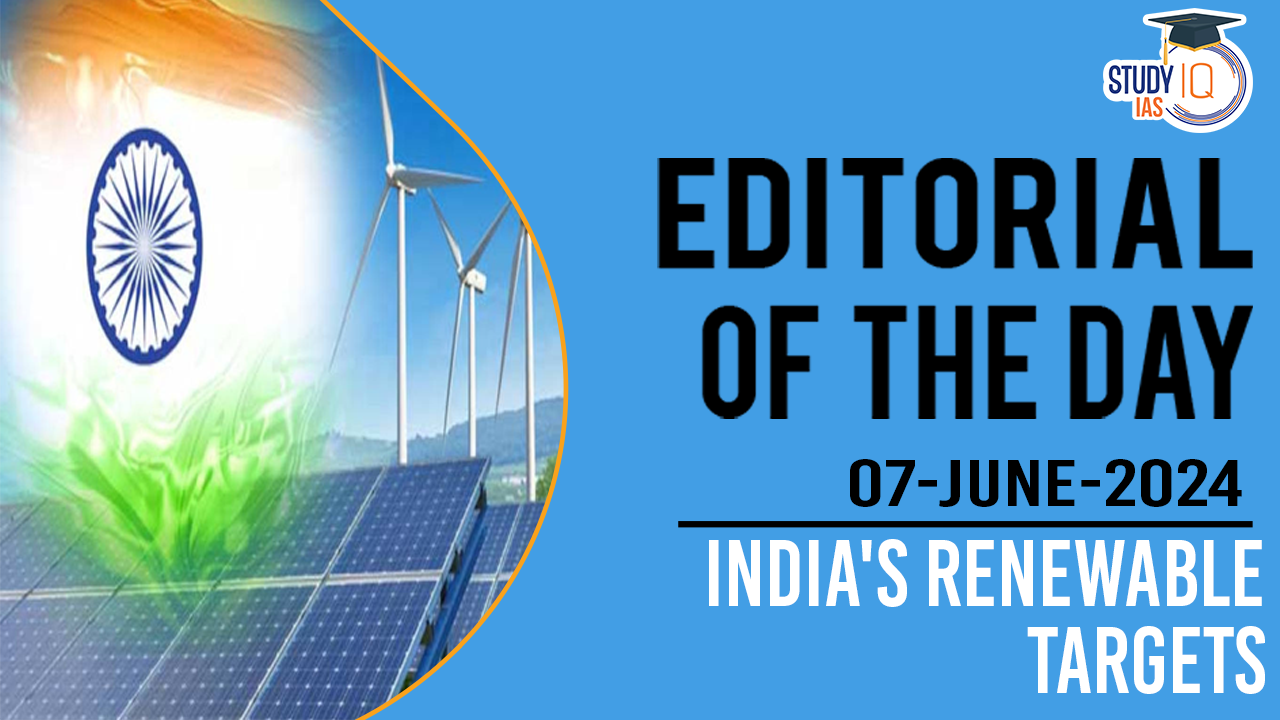Table of Contents
Context: According to Moody’s Rating, India is projected to invest up to $385 billion to achieve its renewable energy (RE) target to reach 500 gigawatts (GW) of renewable energy capacity by 2030.
More In News
- India plans to add non-fossil fuel energy sources to its grid, aiming for an additional 50 GW capacity annually to meet the 500 GW target.
- The investment includes $190 – $215 billion allocated for capacity expansion over the next six to seven years and an additional $150 billion to $170 billion earmarked for transmission and distribution according to the credit ratings agency’s estimates.
- India’s policies aim to support an increase in renewable energy capacity, which is expected to constitute about 43% of its total electricity capacity by 2023-24, drawing substantial private investments.
India and Renewable Energy
- Global Rankings:
- India ranks (according to the REN21 Renewables 2023 Global Status Report):
- 4th globally in both overall Renewable Energy Installed Capacity (including Large Hydro) and Wind Power capacity, and
- 5th in Solar Power capacity.
- India is the 3rd largest energy-consuming country in the world.
- India ranks (according to the REN21 Renewables 2023 Global Status Report):
- At COP26, India committed to achieving 500 GW of non-fossil fuel-based energy by 2030, marking one of the largest expansion plans in renewable energy globally.
| Objectives of Panchamrit |
The five nectar elements presented by the Indian government included:
|
- Growth in Non-Fossil Fuel Capacity: Over the past 8.5 years, India’s installed capacity for non-fossil fuels (including large hydro and nuclear) has grown by 396%, reaching more than 199.85 GW (as of April 2024), which constitutes approximately 45.1% of the country’s total installed capacity.
- Renewable Energy Capacity Growth: Since 2014, India’s total renewable energy capacity (including large hydro) has increased by about 128% and has a combined installed capacity of 191.67 GW.
- Breakdown of Renewable Capacity:
- Wind Power: 46.16 GW
- Solar Power: 82.63 GW
- Biomass/Cogeneration: 10.35 GW
- Small Hydro Power: 5 GW
- Waste to Energy: 0.59 GW
- Large Hydro: 46.92 GW
- Breakdown of Renewable Capacity:
- Foreign Direct Investment (FDI): Up to 100% FDI is permitted under the automatic route in renewable energy generation and distribution projects, in accordance with the provisions of The Electricity Act, 2003.
- Carbon Reduction Targets: India aims to reduce the carbon intensity of its economy by less than 45% by the end of the decade, achieve 50% of cumulative electric power installed capacity from renewables by 2030, and reach net-zero carbon emissions by 2070.
- Green Hydrogen Production: By 2030, India plans to produce 5 million tonnes of green hydrogen, supported by 125 GW of renewable energy capacity.
- Solar and Wind Energy Projects:
- 50 solar parks with a total capacity of 37.49 GW have been approved.
- Offshore wind energy has a target of 30 GW by 2030, with potential sites already identified.
Government Initiatives for Renewable Energy
| Initiative/Scheme | Description |
| National Hydrogen Energy Mission (NHEM) | Aims to position India as a global hub for the production, usage, and export of Green Hydrogen, aiding in the clean energy transition. |
| Production-Linked Incentive (PLI) Scheme | Incentivizes companies for increased sales from domestically manufactured products, boosting local manufacturing and reducing imports. |
| PM-Kisan Urja Suraksha Evam Utthaan Mahaabhiyan (PM-KUSUM) Scheme | The PM-KUSUM scheme aims to provide clean energy to farmers by solarizing agriculture pumps and promoting the use of solar power for irrigation |
| Scheme for Development of Solar Parks and Ultra Mega Power Project | This initiative focuses on developing large-scale solar power parks with dedicated infrastructure to support the installation of solar power plants. |
| Atal Jyoti Yojana (AJAY) | Aims to provide solar street lighting in areas lacking reliable electricity supply, with funding from government and MPLADS. |
| Green Energy Corridor Project | Designed to enhance the flow of renewable energy into the national grid, ensuring efficient transmission across the country. |
| Pradhan Mantri Suryodaya Yojana | Rooftop solar panels are photovoltaic panels installed on the roof of a building that is connected to the main power supply unit. |
Challenges of Renewable Energy
- High Upfront Costs: Renewable energy technologies often require substantial initial investments, making them financially daunting, especially in developing countries where borrowing costs are high.
- Infrastructure and Technical Challenges: Renewable energy installations, such as solar farms and wind turbines, demand significant land, potentially leading to land rights conflicts.
- These systems require ongoing maintenance and skilled technicians for their installation and upkeep.
- Example: The Pavagada Solar Park in Karnataka, also known as the Shakti Sthala, spans over 13,000 acres and highlights the land acquisition and infrastructure challenges associated with large renewable projects.
- Variability and Intermittency: The efficiency of renewable energy sources like solar and wind is heavily dependent on weather conditions and time of day, which affects their reliability.
- This necessitates the development of robust energy storage solutions and grid systems capable of handling these fluctuations.
- Policy and Regulatory Hurdles: Inconsistent government policies and regulatory obstacles can create uncertain investment climates that deter private sector participation.
- Bureaucratic delays and complex permitting processes can further slow down the implementation of renewable energy projects.
- Access to Raw Materials: The renewable energy sector relies on specific raw materials and rare earth metals, which are critical for manufacturing technologies like solar panels and wind turbines.
- Limited access to these materials could impede the growth and sustainability of renewable energy solutions.
- Example: India’s reliance on imports for critical raw materials like lithium and cobalt for battery manufacturing is a challenge, as highlighted by the National Green Hydrogen Mission which aims to reduce this dependency.
- Geographical Disparities: The availability and efficiency of renewable energy technologies vary significantly by region, influenced by natural resource distribution and existing infrastructure.
- Some areas might lack the necessary resources or infrastructure to effectively harness renewable energies.
- Example: The distribution of renewable energy resources like solar and wind varies across India, with states like Gujarat and Rajasthan having higher potential compared to others, leading to disparities in renewable energy efficiency and availability.
- Land Use Challenge and Food Security Concerns in India:
- Large-scale renewable projects, particularly solar parks, require extensive land which could lead to the conversion of agricultural land, impacting food security.
- Estimates suggest that achieving India’s Net Zero targets could require up to 75,000 sq. km of land, potentially leading to significant shifts in land use from agriculture to energy generation.
- The potential reduction in arable land could pose risks to food security, given the critical role of agriculture in supporting the livelihoods and food needs of millions in India.
Way Forward
- Financial Strategies: Implement financial incentives like subsidies, low-interest loans, and grants to offset the initial high costs of large-scale solar projects.
- Promote Public-Private Partnerships (PPPs) to leverage private expertise and funding, reducing public sector financial burdens and accelerating project deployment.
- Capacity Building and Workforce Training: Expand the Suryamitra Skill Development Programs to include a wider range of skills and regions, focusing on various renewable technologies.
- Establish a national certification system for renewable energy technicians to ensure standardised, high-quality installations and maintenance.
- Market Mechanisms and Policy Instruments: Enhance green term-ahead market (GTAM) mechanisms to manage renewable energy intermittency and improve grid integration.
- Adjust GST and safeguard duties on solar components and imports to reduce costs and increase accessibility.
- Regulatory and Policy Framework: Develop a unified national renewable energy policy to address state-level inconsistencies and create a stable investment environment.
- Streamline permitting processes to reduce bureaucratic delays and hasten project initiation.
- Resource and Geographic Optimization: Invest in research to develop technologies suited for regions with lower renewable potential, enabling broader geographic distribution of projects.
- Promote hybrid systems that combine solar and wind energy in suitable regions to maximise efficiency and output.
- Public Awareness and Engagement: Conduct national and local awareness campaigns to highlight the economic and environmental benefits of renewable energy.
- Support community-owned renewable projects to distribute economic benefits and empower local populations.


 India to Host First Global Conference on...
India to Host First Global Conference on...
 How Terror Networks Abuse Digital Tools
How Terror Networks Abuse Digital Tools
 United Nations Population Award 2025: Va...
United Nations Population Award 2025: Va...





















